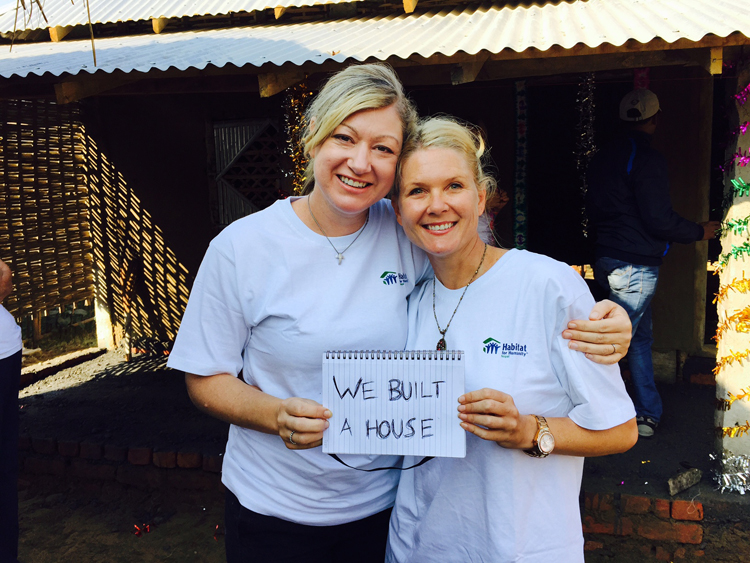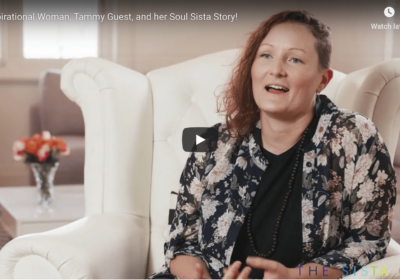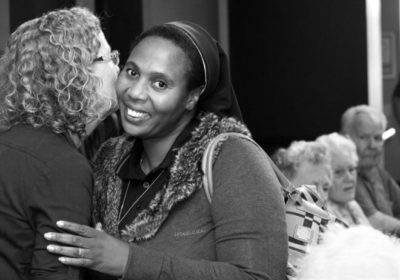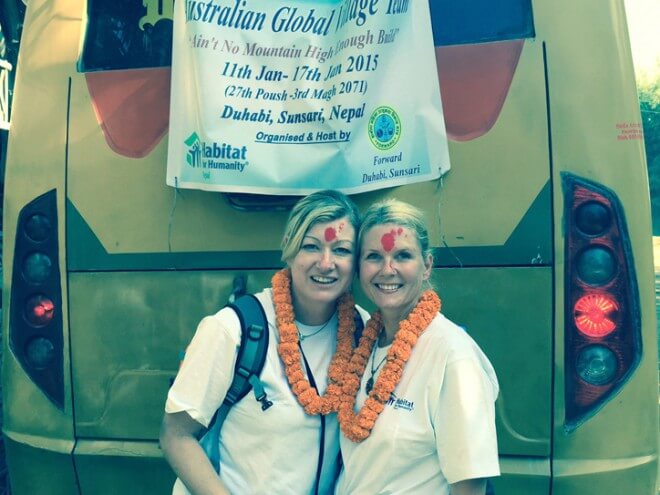
- Stats: 1636 0 0
- Author: Melissa Histon
- Posted: 11/02/2015
- Category: Inspirational Women, Kindness, Mindfulness
Helping the helpless in Nepal changed my life
“You have not lived today until you have done something for someone who can never repay you.” – John Bunyan.
A couple of years ago I was flicking through an issue of Vanity Fair when I saw an ad for Louis Vuitton with a beautiful photo of Angelina Jolie sitting on a timber fishing boat in Cambodia and this line, “A single journey can change the course of a life.”
I never forgot those words and that line was in my head everyday while I was in Nepal in January.
You see, I was there with my friend, Belinda Smith, to help build a home for a widowed lady as part of a Habitat for Humanity build. And I was on a journey not just physically, but of the heart, mind and spirit.
I believe we travel not just to see this wild and wonderful planet. We travel to learn, to grow and to challenge our beliefs and perceptions of the world we live in and of ourselves.
During my 39 + 1 years, I have travelled to many countries and been to some amazing places. I’ve climbed Machu Picchu in Peru, swam in the Blue Grotto at the Isle of Capri, ridden a camel in the Arabian Desert, visited the Queen at Royal Ascot and tangoed in Buenos Aires.
But none of that compares to the week I just spent in a rural village in south-east Nepal, working side-by-side with local villagers, to build an elderly, widow a home.
Every day during that week, my heart was glowing and still swells with joy now whenever I think about it.
WHY?
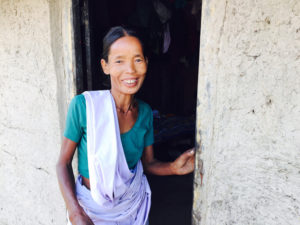
Because we, Belinda and I, were not there for ourselves. We were in Nepal to be of service to someone else, to help the helpless. With us were 12 other people in our build team who had made their way across the world from Australia for the same purpose.
But not only was I being of service and learning about another people, another culture and another way of life, I was also learning about me.
We came as part of Habitat for Humanity’s Global Village program. Habitat for Humanity is an international organisation that has built or repaired over 800,000 homes and helped more than 4 million people worldwide.
Building a safe and secure home gives people the opportunity to be healthier, happier and more secure, and for children to be better nourished and better educated. Building a decent home changes lives.
It took two days for Belinda and I to make our way to Biratnagar, the small city that would be our home base for the five days of the build, stopping over in Kathmandu on the way.
Our team members came from all over Australia – Sydney, Melbourne, Perth, Adelaide with Belinda and I coming from Newcastle.
As a carpenter by trade, Adam from Perth was the only person that had any real building experience: except maybe Sue. Sue was a tried and true home renovator and, at 73 years of age, a jack-of-all-trades who worked like a Trojan all week!
As someone who has zero building skills, I was secretly happy we had a couple of people from home who knew what they were doing.
THE BUILD
The first morning of the build, I woke feeling excited. I wasn’t sure what the day would hold for us, but I couldn’t wait to get to the village.
We met the lady we were building a house for – Jitansari. Her two daughters had married and moved in with their in-laws, and her husband had died. As a widow, Jitansari was considered unimportant in the village of 120 people and left to fend for herself.
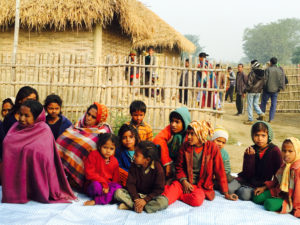
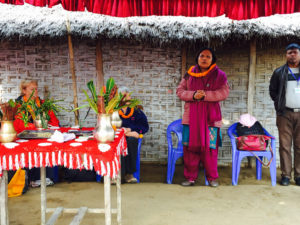
She was living in a basic shelter with a straw roof and dirt floor that turned to mud when it rained. Jitansari was regularly ill and just surviving, not thriving. Our hope was that once she had a well-built, safe and secure home with a concrete floor, she would be able to spend more time caring for her animals and small crops and less time just trying to overcome illness.
Over the next four days, our team of 14 worked together to build her a new home. It was to be made from wooden rafters, split bamboo walls rendered in clay, a concrete floor and corrugated iron roof: and was to be made literally by hand, without modern power tools that make manual work so much easier at home.
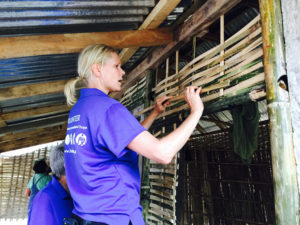
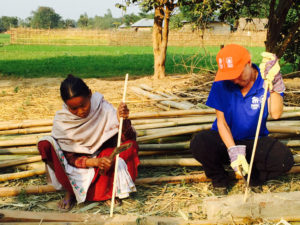
The first day we spent literally cutting, splitting and whittling long, thick lengths of bamboo to fine, pliable (3mm thick by 40mm wide) lengths suitable for weaving into walls. I had the job of whittling the split bamboo to weave-able lengths…with a large curved Nepali knife, kind of like a machete. Yes you read right: a machete. Luckily, I didn’t lose a finger and only scored a few blisters. ‘Yay’ to me for packing a good stash of Band-Aids.
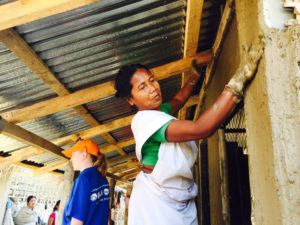
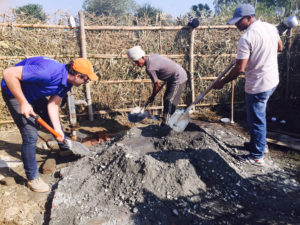
Day Two we spent mixing the mud wall render, which is just like making wine the old-fashioned way. Get your shoes off, roll up your pants and stamp through the mix of dirt, water and hay. Then came the fun part, applying the render to the walls. I thought it would be a fairly easy task. Pick up some render and smear it on the bamboo walls.
But we quickly learned from a few local women that there was more technique required than the Karate Kid’s ‘wax on wax off’.
The next couple of days were devoted to creating a level, flat floor, covering with stones and then concreting; which sounds easy but when there is no cement mixer and no wheelbarrow, it is physically exhausting – ok well it was for me ?
But we worked as a team making long human chains and passing all these elements one-by-one along the line.
Day Five we handed over the completed house to Jitansari in a special ceremony. The local women dressed us all in their traditional clothes and fed us a feast of their Nepali food, which pretty much consisted of rice cooked in various ways and a small bit of goat curry. We were touched!
THE JOY
During the week of the build, I must admit my favourite time of day was when we finished each afternoon – not because we had stopped physically working. I loved it because of the beautiful journey home.
At the end of the working day, we walked about 400m down a dirt road to our parked bus. Along the way, we had chatted with the villagers, took their photos and played with the children.
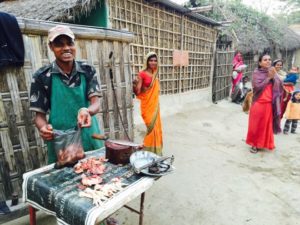
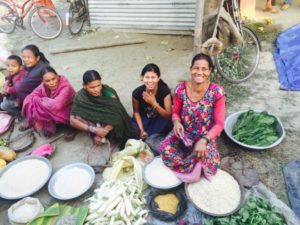
The children would dance along beside us, giggling and posing for photos with their friends and siblings. When I showed them the back of my camera, the children would squeal with delight at their own images.
It’s a modest life but a joyful life. Seeing the children getting such joy out of simple pleasures was a beautiful reminder that life need not be complicated and filled with ‘things’ to make us happy and fulfilled. Joy comes from within.The journey back to Biratnagar on our rickety old bus was heaven. As the sun began to lower and the light shone a golden hue, the countryside would glow. It was magic. Local people in the villages that we passed through would congregate into markets, selling and trading the days harvest from their crops. I would see people still wandering through the fields and the children laughing, playing and swimming in the irrigation canals.
THE REALISATION
This journey to a small Nepali village was life changing. It reminded me how good it feels to be of service; to help the helpless and make someone’s life better.
I realised I am stronger and more independent than I thought. I dug a big hole, split bamboo, rendered a wall, carried stones, water and sand – it was physically tough and I was exhausted afterward – but I did it and I never thought I could.
I realised how fortunate I am to live in this awesome country, Australia, where we have access to education, health and welfare (if needed), running water, sanitation and transport. We have a first rate standard of living in this country.
It reminded me that life does not need to be complex. That happiness is not about things, it is about inner purpose, inner love and simplicity.
It reminded me that I need to stop and take time out to enjoy the simple things: to laugh with my husband, to play with my children, to walk on the beach.
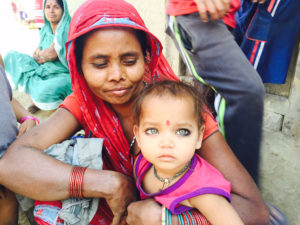
Last year, I spent way too much time pushing myself to please others, to achieve, achieve, achieve: not stopping just to be.
In my everyday life, I don’t take the time to stop and just enjoy my lovely surrounds. I’m embarrassed to say this, but I have lived 800m from the beach for the last seven months. I have not swum in the ocean once during that time. Actually, to be totally honest, I haven’t even set foot on the sand.
I walk up to the beach pavilion, sometimes grab a coffee or take my dogs for a walk along the path or meet my sister, but I haven’t gone to beach just for me to be: to enjoy the sound of the waves, the feel of the water on my skin or breeze on my face. And I have always loved doing that, just going to the beach to BE!
Lastly, I want to thank Belinda for suggesting we go! You are amazing Sista and I’m so grateful we shared this experience and I look forward to our next trip to build a house in January 2016. If you want to join us next year (you being the person reading this), email me at info@thesistacode.com.
If you want to join for a life-changing journey to Nepal, Tibet and China later this year, you can register your interest here http://www.htg.com.au/2015/19-day-nepal-tibet-china-in-focus-with-melissa-histon-group/
Mel xx
